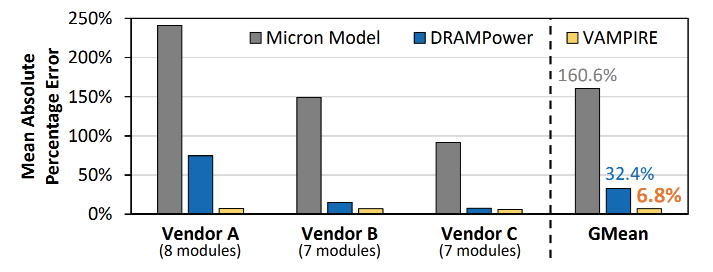What Your DRAM Power Models Aren’t Telling You: Lessons from a Detailed Experimental Study

Main memory (DRAM) consumes as much as half of the total system power in a computer today, due to the increasing demand for memory capacity and bandwidth. There is a growing need to understand and analyze DRAM power consumption, which can be used to research new DRAM architectures and systems that consume less power. A major obstacle against such research is the lack of detailed and accurate information on the power consumption behavior of modern DRAM devices.
Based on our detailed analysis and characterization data, we develop the Variation-Aware model of Memory Power Informed by Real Experiments (VAMPIRE). VAMPIRE is a new, accurate power consumption model for DRAM that takes into account (1) module-to-module and intra-module variations, and (2) power consumption variation due to data value dependency. We show that VAMPIRE has a mean absolute percentage error of only 6.8% compared to actual measured DRAM power. VAMPIRE enables a wide range of studies that were not possible using prior DRAM power models. As an example, we use VAMPIRE to evaluate the energy efficiency of three different encodings that can be used to store data in DRAM. We find that a new power-aware data encoding mechanism can reduce total DRAM energy consumption by an average of 12.2%, across a wide range of applications. We have open-sourced both VAMPIRE and our extensive raw data collected during our experimental characterization.
Publication Date
Research Area
External Links
Uploaded Files
Copyright
Copyright by the Association for Computing Machinery, Inc. Permission to make digital or hard copies of part or all of this work for personal or classroom use is granted without fee provided that copies are not made or distributed for profit or commercial advantage and that copies bear this notice and the full citation on the first page. Copyrights for components of this work owned by others than ACM must be honored. Abstracting with credit is permitted. To copy otherwise, to republish, to post on servers, or to redistribute to lists, requires prior specific permission and/or a fee. Request permissions from Publications Dept, ACM Inc., fax +1 (212) 869-0481, or permissions@acm.org. The definitive version of this paper can be found at ACM's Digital Library http://www.acm.org/dl/.
